Fighting the Format: World Magic Cup Special

The World Magic Cup beckons! It seems like only yesterday two of Troll Traders’ own – Sam Rolph and Dave Murphy – earned their places in the prestigious tournament, through long and hard-fought battles of Standard and Ixalan draft. Sam and Dave, I’m rooting for you.
Seeing as this year’s WMC is going to be primarily in Unified Team Standard, this seems like as good a time as any to take stock of the Standard format. What are the key cards, and key decks? Which options should each team be endeavoring to include in their total 225 card deck list, and what decks do these cards lend themselves to?
For those familiar with my series ‘Fighting the Format’, coming up will be a recap of several decks I’ve looked into in further detail previously; for those new to my content, go check out my back catalogue to get a deep dive on the intricacies of these decks.
With that, let’s get started!
Key Cards
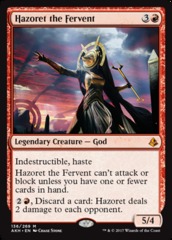
Introducing the end-boss of every aggressive red deck, we have Hazoret. Hazoret provides what every aggro deck needs; a big, hasty, resilient threat that is just as comfortable thwacking your opponent across the head as she is turning excess Mountains into Shocks. There is no card that undoes a mulligan or two quite as well as Haz, and just her potential presence forces the opponent into plays and lines that they’d definitely rather not be making. She’s the driving force behind Ramunap Red’s presence in Standard, and a key role-player in various other Red decks including BR and Mardu.
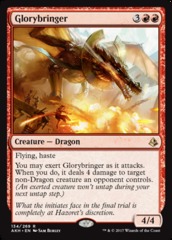
Another key tool in the Red decks is Stormbreath Dragons’ younger, sleeker and more successful cousin, Glorybringer. Glorybringer does several things very well; it pressures Planeswalkers, it clocks the opponent for big chunks of damage out of nowhere, and it embarrasses X/4 creatures worldwide. Even in matchups where the opponent isn’t packing great targets (i.e. Control decks), Glorybringer provides a powerful follow-up to a Fumigate or Bontu’s Last Reckoning that must be answered. Glory is the perfect top-end to the traditional Temur Energy builds, and is a sideboard staple out of every non-Control deck capable of casting it.
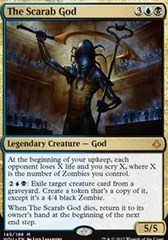
Next up is the best last word since, well, Last Word. The Scarab God is big, nigh unkillable, drains the opponent’s life on a stalled board, generates power at the same rate you have mana available, and even offers some bonus card filtering for your trouble. It is precisely because of the Gods like Scarab and Hazoret that cards like Confiscation Coup and Vraska’s Contempt see so much play; if you get to untap with a Scarab God, you are going to win the game. There’s a reason why this not-so-little bug holds the title of priciest card in Standard, and why four-colour Energy and Sultai hold such a metagame presence.
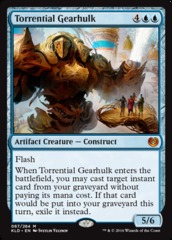
In my article last week, I compared Torrential Gearhulk to Snapcaster Mage. I’m not the first nor the last to have said it, but the comparison is apt: Torrential is the biggest, fattest, and most threatening Snapcaster you’ll ever see. Six untapped lands from a Control deck threatens at any point to cast any card out of the owners’ graveyard, block any ground creature unable to punch past a whopping 5/6, and then be left with a must-answer body that threatens to tear chunks out of both players and Planeswalkers. If you’re playing a Blue control deck, it’s not a question of whether you should play the Hulk, but how many you should play.
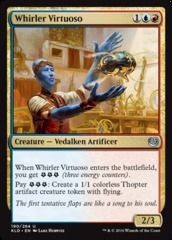

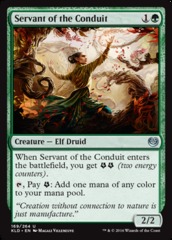
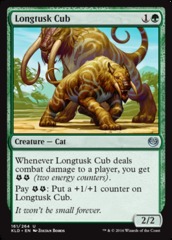
Finally, we have the backbone of the various Energy decks. While there are certainly other options out there (my Sultai Midrange deck is not embarrassed it’s packing four Die Young!), these are some of the reasons to be playing Energy decks. Every single one of these cards offers two things: more of the titular resource, and either somewhere to use it or an extra card. The incremental value offered by this package and diversity of threats it produces is not to be stifled with, and is likely to continue to be a mainstay in Standard until Kaladesh rotates.
So, we know what the key cards are in Standard. What can you do with them?
Key Decks
Aggro
Ramunap Red
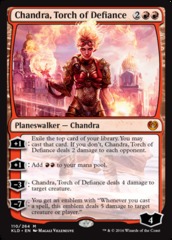
If you want to make sure you’ve got time for a drink or snack inbetween rounds, then Ramunap Red is your go-to. Red ends games in short order by deploying tons of little creatures, preventing the opponent from blocking, then throwing Hazorets and burn spells at the opponent until they perish. Even if the opponent does manage to stabilise, Red offers mana sinks in Hazoret, Earthshaker Khenra and Ramunap Ruins, never letting the opponent to get comfortable.
Mono-Black Aggro
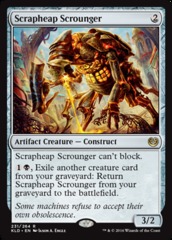
When Settle the Wreckage and Fumigate start taking the fun out of your Red-Control matchup, Mono-Black happens. With even more sticking power and a crushingly one-sided matchup versus Control, Black is a force to be reckoned with. Night Market Lookout and Vicious Conquistador lead the charge as effective two-power one-mana creatures, while Dread Wanderer and Scrapheap Scrounger ensure Black is never running out of steam.
Midrange
Temur Energy/Four-Colour Energy
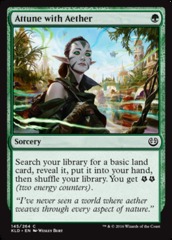
The boogeyman of the format, Temur Energy is the barrier between all potential brews and success. If you can’t beat Temur, you are not a deck. As mentioned above, the variety of threats and angles of attack Temur can produce allow it’s pilot a lot of play and control over the direction of the game, while the access to three (or even four) colours leaves a ton of scope for both main and sideboard tweaking. You’re expecting a lot of aggro? Jam Magma Spray. Lots of grindy mirror matches? In comes The Scarab God. What about a bunch of Control? Duress and Negate want a word. Temur is to Standard what Jund is to Modern – good against everything, not great against anything, but a knowledgable and skilful player can turn those small edges intro trophies.
Sultai Energy
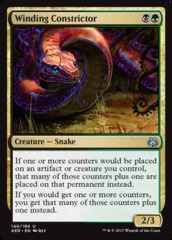
If Temur is ‘Midrange’, Sultai is ‘midrange’. While they share a lot of the same the cards – Attune, Cub, sometimes Servant and Hydra – Sultai has a much more aggressive bent, utilising the synergies throughout with Winding Constrictor. Temur can have quick starts with Longtusk Cub; Sultai plays all must-kill two drops. A living Snake snowballs extremely quickly alongside most of the cards in the deck, and Walking Ballista provides both board control and even reach in direct damage. Sultai has trouble with the big Red cards in Chandra, Torch of Defiance and Glorybringer, but if the game doesn’t get to that point it hardly matters. Sultai is a great choice for those who like to interact with their opponent, but also like big Green things that turn sideways.
UW Monument
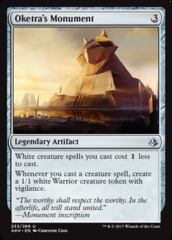
Now this is a deck I didn’t think I’d see again. My first ‘Fighting the Format’ article covered UW Monument during Hour of Devastation Standard, and twenty of it’s twenty-four creatures rotated! As it turns out, near-infinite 1/1s are still a pretty great proposition, as are four-mana Mulldrifters in Cloudblazer. While the other Midrange decks rely on high card quality and big individual threats to take down games, Monument uses synergies to go wide, burying the opponent. Monument is a solid middle-ground between traditional Midrange and the next deck…
Combo
BWx Tokens
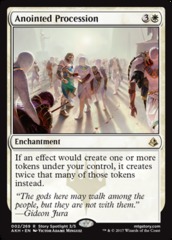
For those who really want to go wide, forget Monument. Monument creates circa ten free guys, plays an anthem, and ends the game. That is child’s play. Tokens uses the power of Legion’s Landing and Hidden Stockpile alongside Anointer Priest and Anointed Procession to make a million(ish) tokens while gaining a million(ish) life. While Tokens isn’t a Combo deck in the same way as we’ve seen before (cough Four-Colour Saheeli cough), it’s difficult for Tokens to lose once it has it’s engine in place. The core of the deck is very much BW, but after that it’s customisable – if you want extra grind value, play Blue for Champion of Wits, Search for Azcanta and sideboard counter-magic. If you’re after a way to win the mirror match, play Green for Vraska, Relic Seeker and sideboard enchantment removal.
Gift
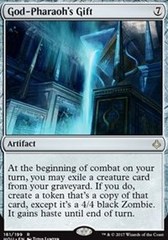
There are two core Gift strategies available: the Esper shells, playing Gate to the Afterlife with Black removal and Hostage Takers, and the UW build, utilising Refurbish to reanimate a Gift as early as turn four. The former plays a better ‘fair’ game of Magic due to it’s generally higher card quality, in Taker, Fatal Push etc, while the latter gets to it’s combo faster due to a high concentration of card draw and filtering. Either way, an early Gift means lights out for the opponent. This engine is a mix of sorts between what Midrange and Tokens shells are trying to do; Midrange wants to play big haymakers (Gift for Angel of Invention), while Tokens wants to reach an unstoppable long-game (repeated Gift activations, Champion of Wits etc). Gift is sort of the Midrange players’ Combo deck, if you will!
Pummeller

Pummeller is a traditional Combo deck – piece together a Pummeller, a bunch of Energy, and a big pump spell. CRUNCH. You’ll generally find Pummeller in the Temur colours, but the more established RG has recently been replaced by UG, losing aggressive creatures like Voltaic Brawler in favour of streamlining the Combo element of the deck with Cartouche of Knowledge. Utilising the strength of the usual Energy package a la Servant, Hydra etc allows Pummeller to play a regular game of Magic, engineering the opponent into a spot where they’re forced to tap out to keep up with your board. Once that happens, they’re just a quick Cartouche and Larger than Life away from signing the match slip in your favour.
Control
Approach/Non-Approach

I realise how unhelpful lumping two decks with polar opposite titles together seems, but it’ll make sense – trust me! Both the Approach and non-Approach decks share the same core; traditional Blue Control, utilising counterspells, card draw and whichever second colour’s removal in Fatal Push, Vraska’s Contempt and Fumigate. In doing so, they draw out the game before landing a giant finisher and clinching the win; it doesn’t matter whether that’s via Approach, The Scarab God, Torrential Gearhulk or even Drake Haven. The most common colour pairs you’ll see are UW and UB, but R and even G as splashes aren’t unheard of; the former offering great removal in Harnessed Lightning and the latter an engine via Attune with Aether, Rogue Refiner and Dynavolt Tower. However you slice it, if you really want control over the flow of the game, sleeve up your Disallows and go to town!
Summary
And that’s Standard in a nutshell. While this list isn’t exhaustive – I’m sure there are some of you reading this screaming for Mardu Vehicles, GW Aggro and even Decoction Module builds – it’s a reasonably thorough take on the options available to our countrymen this weekend. Which options use the least of the available card pool? Which deck combinations will be successful? Which strategies will match up well against the expected field? Post your thoughts in the comments below, and join me in following the action this weekend.
As always, thanks for reading, and good luck.





